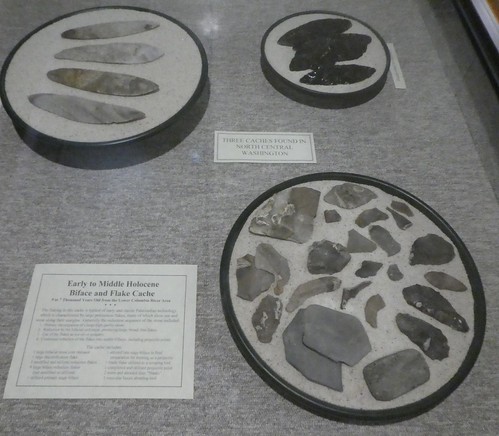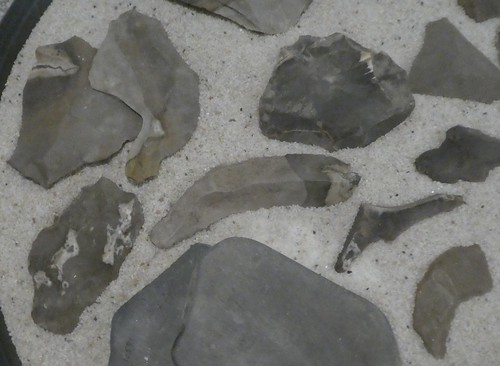Washington’s Columbia Plateau—the area between the Cascade Mountains on the west and the Rocky Mountains on the east—was first occupied by the ancestors of American Indians at a time when the northern portion of the region was still covered by the Cordilleran ice sheet. From 21,000 years ago until about 14,000 years ago, this ice sheet reached its maximum and then began to retreat north.
With regard to chronology, some archaeologists refer to the period between the end of the Ice Ages and about 6000 BCE as the Early Period. In their chapter on prehistory in the Handbook of North American Indians, Volume 12: Plateau, James Chatters and David Pokotylo write:
“Climates were initially more continental than they are today and were characterized by greater seasonal variation in temperature.”
The Indian people living in the Plateau region at this time are sometimes called Paleoindians (Paleo-Indians). These were food foragers who hunted, fished, and gathered wild plants for food and fiber.
James Chatters and David Pokotylo refer to the period between 6000 BCE and 2000 BCE as the Middle Period. James Chatters and David Pokotylo write:
“Climatic conditions continued warmer than in modern times. However, the climate became more maritime after 6000 B.C., allowing conifer forests to move downslope in the north and perhaps in the east, and shrub steppes to replace grasslands in the Columbia Basin.”
Stone Tools
Like human beings everywhere, Indians used stone as their primary material for toolmaking for thousands of years. There are three basic ways that people make stone into useful tools: (1) by breaking (a process commonly called flintknapping), (2) by grinding, and (3) by pecking. Tools made by flintknapping included points (both spearpoints and later arrowpoints), knives, scrapers, and other cutting implements. Ground stone tools include hammers, grinding bowls, and dishes. Pecking can be used for making hammers and bowls.
The process of breaking stone to form tools is not a random process: it is not simply a matter of banging two stones together. The toolmaker will take a piece of stone and shape it into a culturally acceptable form. Thus, in a culture the same basic tool shapes appear over and over again.
There are two techniques involved in making flaked stone tools. The first step usually involves percussion flaking in which a core is struck by a hammer (usually made out of a hard stone, but “soft” hammers made from antler and wood are also used).
The flintknapping process usually begins with a core—a large stone from which flakes are struck. Depending on the type of stone used and the shape of the core, the flakes can have sharp edges and be used as cutting tools—knives and scrapers—without further modification.
While flakes are often struck from the core with direct percussion, indirect percussion can also be used. In his book Flintknapping: Making and Understanding Stone Tools, John Whittaker explains:
“In indirect percussion a punch of antler or wood or other hard material is placed on the platform and struck with a hammer, instead of striking the stone directly with the hammer. This allows the force to be directed very precisely, an important factor in making blades, which requires a carefully prepared core with an even platform and regular ridges for the blades to follow.”
Once the basic shape of the tool is obtained, it can then be retouched using pressure flaking. John Whittaker writes:
“Pressure flaking involves removing flakes from the edge of a tool with an antler or bone tool, rather than striking it.”
Archaeologists Ian Shaw and Robert Jameson, in their book A Dictionary of Archaeology, report:
“Pressure flaking shows a much greater degree of precision and enables flint knappers to detach regular flakes.”
John Whittaker writes:
“The pressure-flaked ‘arrowhead’ is the most characteristic American stone artifact. Even people who know nothing about prehistory recognize ‘arrowheads.’”
To be technically precise these “arrowheads” are small, bifacially flaked projectile points, some of which were used on arrows.
It should also be noted that stone projectile points often break and are re-fashioned. This means that small arrowheads may have started out as larger arrowheads or as spearpoints.
One important thing to understand about stone projectile points is that not all stone can be used. In flintknapping, Indian people needed stones that would break in a predictable fashion and would provide a sharp edge. In other words, arrowhead makers had to have some understanding of geology.
Museum exhibit
The Cashmere Museum in Cashmere, Washington has a display of a biface and flake cache dating to 9,000 to 7,000 years ago. According to the Museum:
“The flaking in this cache is typical of early and classic Paleoindian technology, which is characterized by large percussion flakes, many of which show wear along their margins.”




 Shown above are some obsidian blades.
Shown above are some obsidian blades.
Obsidian, a natural glass produced by volcanic action, was a valued natural resource for many tribes. A blade knapped from obsidian is sharper than a surgical scalpel. In some places obsidian is found in massive flows but it can be difficult to extract. The obsidian in this display may have come from quarries in Oregon or California.
Today’s professional archaeologists often use obsidian artifacts such as these for visualizing ancient trade routes and changes in these routes over time. It is often possible to determine the actual quarry from which the stone was obtained.


More Ancient America
Ancient America: Avonlea, the early bow hunters
Ancient America: The Old Copper People
Ancient America: Columbia River Rock Art (Photo Diary)
Ancient America: The Great Basin Archaic
Ancient America: The Columbia Plateau, 2000 to 500 BCE
Ancient America: Hunting Tools in British Columbia
Ancient America: Tulalip Archaeology (Photo Diary)
Ancient America: The East Wenatchee Clovis Site (museum tour)


